Michael Rickard's Blog, page 18
September 19, 2018
Destruction and Diaspora: Life in "Their Dogs Came with Them: A Novel"
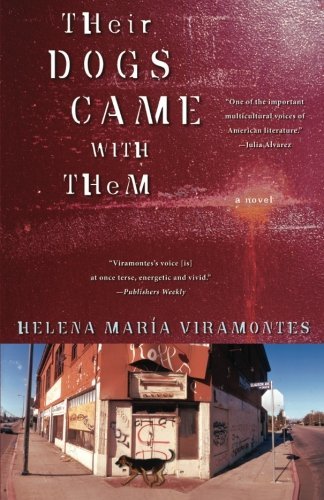 Copyright (c) 2018 by Michael Rickard IIEditor's Note:The border is a hot topic right now thus my class in borderland literature provided some insight into authors' thoughts on living between two worlds. Here is an essay I wrote on Emma Pérez' Loving Pedro Infante. Spoilers abound:Helena Maria Viramontes’ Their Dogs Came with Them: A Novel (“Dogs”) deals with the effect of ever-changing boundaries on individuals and culture, showing a microcosm of the borderland theme of displacement. Here, Viramontes shows the effects of a neighborhood mutilated by the construction of a highway, focusing on a group of individuals over ten years. The book’s often disjunctive storytelling simulates the effects of displacement including uncertainty and unpredictability. This ties in with the borderland theme of “we didn’t cross the border, the border crossed us” as the residents’ community is taken without their permission and with no regard for the effects on them. This displacement destroys the traditional nuclear family and the community, with little chance of escape for its victims.Viramontes’ novel is not easy to follow, but this seems to be a conscious effort to simulate the lives of the novel’s characters. Each character’s life is disrupted by the construction of the freeway and continues to be disrupted until the novel’s end, often with tragic results. The narrative can be confusing and Viramontes’ jumps back and forth in time, with the reader experiencing uncertainty what is going on and where they are, similar to the novel’s characters. “Dogs” explores the concept of the postmetropolis—Edward Soja’s concept of the postmodern metropolis. Dale Pattison’s article shows the impact of the postmetropolis on a traditional urban setting, “One of the chief features of the postmetropolis is the disappearance of an urban center, or a downtown district that functions as a hub for commerce, housing, and cultural production for the city, at large” (120). This can be seen in “Dogs” as the characters’ world is destroyed by the highway construction which divides and destroys portion of a once strong community. The destruction of the neighborhood disempowers its residents. As Pattison notes, “Erasing these sites of memory and co-opting the channels for necessary psychological and spatial production, the city enacts subtle, but powerful, institutional violence” (122). The neighborhood’s destruction leads to a diaspora, with both physical and mental consequences. Consequences include the destruction of the nuclear family, the loss of cultural identity, and mental health problems.The traditional nuclear family is destroyed in “Dogs” with children raised by their grandparents, single parents, or even raised on the streets. Mirroring reality, the characters find surrogate families whether it’s siblings Luis Lil’ Lizard and Turtle finding attachments in a street gang, Ermila’s sororal bond with her girlfriends, Tranquilina’s devotion to her faith, or sister Ana’s almost motherly devotion to her troubled brother Ben, a situation caused when Ana and Ben’s mother disappears.The theme of displacement is central in “Dogs” with characters unable to navigate their world as it is in constant flux. This often results in tragic consequences. For example, young Ben is sent into a store to buy sneakers, but the young boy is unable to navigate the world, confused about what to do and fearful of his father. The father has relied on the child’s mother for things such as buying clothes and has no idea how to interact with his son. Ben wanders the store, similar to how the novel’s characters wander the city in search of meaning and stability. Turtle finds herself displaced from her home, living on the streets and trying to escape the gang. Her chance at a job is destroyed when she immerses herself in drugs and forgets she is supposed to start a new job. Her drug-induced fog mirrors the fog the characters find themselves in thanks to the displacement caused by the freeway construction.In “Dogs”, memory is often all that is left to remember, and memory is always a tricky thing. Pattison establishes the need to remember early on, “Chavela seems to realize the importance of preserving the memory of the blue house and its symbolic role within the community” (123). Chavela is shown to have had a long life in the neighborhood, with rich experiences that will soon be left to memory. Ermila does her best to remember Chavela, taking scraps of wallpaper from the house and burning her fingers with a cigarette left on a windowsill, but the destruction of landmarks, i.e. buildings, makes it difficult for memories to last.Escape is seen as impossible in “Dogs” with characters longing to escape, but finding escape difficult to achieve. Luis tells Turtle of solace in New Mexico, but has no idea how to get away. Luis also finds escape from the city, but it is in the form of being drafted to Vietnam, a proverbial case of escaping the fryer and going into the fire pan. Nacho tries to escape the city, but is murdered before he can. Ben’s attempts to escape the department store caused by his father’s admonition not to “dilly-dally,” coupled with Ben’s lack of skills in purchasing a pair of sneakers, results in tragedy when Ben drags a child with him, resulting in the child’s death and Ben’s physical and mental injury. Ben’s life is forever altered by this escape attempt as he lives with the guilt of causing the boy’s death, but being credited with trying to save the boys life. While “Dogs” is ambiguous about whether Ben’s mental state already existed or was furthered by this incident, there is little doubt the postmetropolis has contributed to Ben’s problems.Viramontes’ Their Dogs Came with Them provides powerful examples of how diaspora impacts people, focusing on a neighborhood level (as what takes place the novel), but providing an allegory for larger settings such as the displacement of Mexicans after the Mexican-American War. This diaspora destroys families and individuals on a mental, spiritual, and cultural level as seen with the novel’s characters and their bleak lives.Works CitedPattison, Dale. "Trauma and the 710: The New Metropolis in Helena María Viramontes’s TheirDogs Came with Them." Arizona Quarterly: A Journal of American Literature, Culture, and Theory, vol. 70 no. 2, 2014, pp. 115-142. Project MUSE, muse.jhu.edu/article/547166.Viramontes, Helena Maria. Their Dogs Came with Them: A Novel. Atria Books, 2008.
Copyright (c) 2018 by Michael Rickard IIEditor's Note:The border is a hot topic right now thus my class in borderland literature provided some insight into authors' thoughts on living between two worlds. Here is an essay I wrote on Emma Pérez' Loving Pedro Infante. Spoilers abound:Helena Maria Viramontes’ Their Dogs Came with Them: A Novel (“Dogs”) deals with the effect of ever-changing boundaries on individuals and culture, showing a microcosm of the borderland theme of displacement. Here, Viramontes shows the effects of a neighborhood mutilated by the construction of a highway, focusing on a group of individuals over ten years. The book’s often disjunctive storytelling simulates the effects of displacement including uncertainty and unpredictability. This ties in with the borderland theme of “we didn’t cross the border, the border crossed us” as the residents’ community is taken without their permission and with no regard for the effects on them. This displacement destroys the traditional nuclear family and the community, with little chance of escape for its victims.Viramontes’ novel is not easy to follow, but this seems to be a conscious effort to simulate the lives of the novel’s characters. Each character’s life is disrupted by the construction of the freeway and continues to be disrupted until the novel’s end, often with tragic results. The narrative can be confusing and Viramontes’ jumps back and forth in time, with the reader experiencing uncertainty what is going on and where they are, similar to the novel’s characters. “Dogs” explores the concept of the postmetropolis—Edward Soja’s concept of the postmodern metropolis. Dale Pattison’s article shows the impact of the postmetropolis on a traditional urban setting, “One of the chief features of the postmetropolis is the disappearance of an urban center, or a downtown district that functions as a hub for commerce, housing, and cultural production for the city, at large” (120). This can be seen in “Dogs” as the characters’ world is destroyed by the highway construction which divides and destroys portion of a once strong community. The destruction of the neighborhood disempowers its residents. As Pattison notes, “Erasing these sites of memory and co-opting the channels for necessary psychological and spatial production, the city enacts subtle, but powerful, institutional violence” (122). The neighborhood’s destruction leads to a diaspora, with both physical and mental consequences. Consequences include the destruction of the nuclear family, the loss of cultural identity, and mental health problems.The traditional nuclear family is destroyed in “Dogs” with children raised by their grandparents, single parents, or even raised on the streets. Mirroring reality, the characters find surrogate families whether it’s siblings Luis Lil’ Lizard and Turtle finding attachments in a street gang, Ermila’s sororal bond with her girlfriends, Tranquilina’s devotion to her faith, or sister Ana’s almost motherly devotion to her troubled brother Ben, a situation caused when Ana and Ben’s mother disappears.The theme of displacement is central in “Dogs” with characters unable to navigate their world as it is in constant flux. This often results in tragic consequences. For example, young Ben is sent into a store to buy sneakers, but the young boy is unable to navigate the world, confused about what to do and fearful of his father. The father has relied on the child’s mother for things such as buying clothes and has no idea how to interact with his son. Ben wanders the store, similar to how the novel’s characters wander the city in search of meaning and stability. Turtle finds herself displaced from her home, living on the streets and trying to escape the gang. Her chance at a job is destroyed when she immerses herself in drugs and forgets she is supposed to start a new job. Her drug-induced fog mirrors the fog the characters find themselves in thanks to the displacement caused by the freeway construction.In “Dogs”, memory is often all that is left to remember, and memory is always a tricky thing. Pattison establishes the need to remember early on, “Chavela seems to realize the importance of preserving the memory of the blue house and its symbolic role within the community” (123). Chavela is shown to have had a long life in the neighborhood, with rich experiences that will soon be left to memory. Ermila does her best to remember Chavela, taking scraps of wallpaper from the house and burning her fingers with a cigarette left on a windowsill, but the destruction of landmarks, i.e. buildings, makes it difficult for memories to last.Escape is seen as impossible in “Dogs” with characters longing to escape, but finding escape difficult to achieve. Luis tells Turtle of solace in New Mexico, but has no idea how to get away. Luis also finds escape from the city, but it is in the form of being drafted to Vietnam, a proverbial case of escaping the fryer and going into the fire pan. Nacho tries to escape the city, but is murdered before he can. Ben’s attempts to escape the department store caused by his father’s admonition not to “dilly-dally,” coupled with Ben’s lack of skills in purchasing a pair of sneakers, results in tragedy when Ben drags a child with him, resulting in the child’s death and Ben’s physical and mental injury. Ben’s life is forever altered by this escape attempt as he lives with the guilt of causing the boy’s death, but being credited with trying to save the boys life. While “Dogs” is ambiguous about whether Ben’s mental state already existed or was furthered by this incident, there is little doubt the postmetropolis has contributed to Ben’s problems.Viramontes’ Their Dogs Came with Them provides powerful examples of how diaspora impacts people, focusing on a neighborhood level (as what takes place the novel), but providing an allegory for larger settings such as the displacement of Mexicans after the Mexican-American War. This diaspora destroys families and individuals on a mental, spiritual, and cultural level as seen with the novel’s characters and their bleak lives.Works CitedPattison, Dale. "Trauma and the 710: The New Metropolis in Helena María Viramontes’s TheirDogs Came with Them." Arizona Quarterly: A Journal of American Literature, Culture, and Theory, vol. 70 no. 2, 2014, pp. 115-142. Project MUSE, muse.jhu.edu/article/547166.Viramontes, Helena Maria. Their Dogs Came with Them: A Novel. Atria Books, 2008.
Published on September 19, 2018 23:46
September 16, 2018
Book Review: Arn Anderson 4-Ever
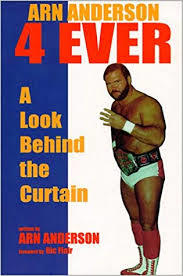 "The Enforcer" Arn Anderson is a well-respected wrestler who rose to fame in the mid-80's becoming a founding member of the Four Horsemen and going on to have a successful career until injuries forced him to retire early. Fans may be surprised to learn "The Enforcer" wrote his memoir nearly two decades ago, a book that's still available. How does it stand up to other wrestler biographies? Check out my review hereOriginally presented at Canadian Bulldog's World
"The Enforcer" Arn Anderson is a well-respected wrestler who rose to fame in the mid-80's becoming a founding member of the Four Horsemen and going on to have a successful career until injuries forced him to retire early. Fans may be surprised to learn "The Enforcer" wrote his memoir nearly two decades ago, a book that's still available. How does it stand up to other wrestler biographies? Check out my review hereOriginally presented at Canadian Bulldog's World
Published on September 16, 2018 23:17
September 13, 2018
Using Technology to Improve Dictionaries
Richard Trench’s speech On Some Deficiencies in our English Dictionaries and the OED Proposal for the Publication of a New Dictionary demonstrates how lexicographers have kept certain principles while trying to improve dictionaries. It also exemplifies how methodologies can be improved upon with new technology. These articles show the continuing debate over what words (if any) should be excluded from dictionaries. Trench comments, “A Dictionary is a historical monument, the history of a nation contemplated from one point of view, and the wrong ways into which a language has wandered, or attempted to wander, may be nearly as instructive as the right ones in which it has travelled: as much as may be learned, or nearly as much, from its follies as from its wisdom” (Trench 6). The Philological Society concurs, stating “We entirely repudiate the theory, which converts the lexicographer into an arbiter of style, and leaves it to his discretion to accept or reject words according to his private notions of their comparative elegance or inelegance” (180). This remains an issue as discussed in class and in our text, with people debating on the appropriateness of certain words such as profanities, regionalisms, or slang.As Landau discusses in the course text, there is no known limit to the number of words in the English language. I believe our expanding population and increased diversity have increased the number of words in our language. Society has been exposed to words from minority cultures and subcultures thanks to the expansion of media and more interaction with people from different backgrounds, be they ethnic, religious, or otherwise. For example, the plethora of television networks have led to a number of shows[1] targeted to different demographics such as ethnic, religious, and age. These shows are not always watched by the target demographics, exposing people to new cultures and subcultures including vocabularies (the question of how representative of said cultures these shows are is open to debate). While society still has a long way to go in terms of acceptance of “the other,” people are less segregated than they were in the past. This has to more exposure to words outside the mainstream. This means there are many new words to be processed and assessed.I believe technology is expanding the way dictionaries are compiled and how much information they contain. Obviously, the fixed space of print dictionaries is still an issue, but online dictionaries offer theoretically unlimited space for words. Online dictionaries can be tailored for users much easier than they can in print dictionaries whether it be technical dictionaries, etymological dictionaries, or general dictionaries. The only restriction to online dictionaries is the cost of compiling these dictionaries and determining what goes in them and what doesn’t.Just as the Philological Society asked for help with providing word usages, I believe the manufacturers of online dictionaries can rely on volunteers. While crowdsourced dictionaries (information compiled by a group of people) present challenges such as accuracy and reliability, they present a starting point for lexicographers and trained volunteers to mine data using corpus linguistics. With optical recognition technology, voice recognition technology, and improved computer processing power, lexicographers can look to things such as mining media such as print, music, television and film for new words. For example, books, newspapers, and magazines can be scanned and examined for new words or new meanings of existing words. Voice recognition technology can be utilized to identify music, television, and film for new words also[2] As I’ve mentioned in previous blogs, corpus linguistics can be aided by improvements in optical and voice recognition technology.The articles in this week’s class show that dictionaries can rely on established principles for the information they contain and use new and/or improved technology to expand their content.[1] Exposure is not limited to television as mediums such as rap music have provided exposure also, with rapper Chuck D. (and others) discussing how rap is its own news outlet.[2] This is conjecture on my part as I do not know if voice recognition technology has improved to the point where this can be accomplished in a cost-effective manner.Works Cited“OED Proposal for new Dictionary and Appeal to Public.”https://buffalostate.open.suny.edu/bb.... Accessed 11 Apr. 2018.Trench, Richard Chenevix. On Some Deficiencies in Our English Dictionaries: Being theSubstance of Two Papers, Read Before the Philological Society, Nov; 5, and Nov; 19, 1857 (Classic Reprint). Forgotten Books, 2018.
These articles show the continuing debate over what words (if any) should be excluded from dictionaries. Trench comments, “A Dictionary is a historical monument, the history of a nation contemplated from one point of view, and the wrong ways into which a language has wandered, or attempted to wander, may be nearly as instructive as the right ones in which it has travelled: as much as may be learned, or nearly as much, from its follies as from its wisdom” (Trench 6). The Philological Society concurs, stating “We entirely repudiate the theory, which converts the lexicographer into an arbiter of style, and leaves it to his discretion to accept or reject words according to his private notions of their comparative elegance or inelegance” (180). This remains an issue as discussed in class and in our text, with people debating on the appropriateness of certain words such as profanities, regionalisms, or slang.As Landau discusses in the course text, there is no known limit to the number of words in the English language. I believe our expanding population and increased diversity have increased the number of words in our language. Society has been exposed to words from minority cultures and subcultures thanks to the expansion of media and more interaction with people from different backgrounds, be they ethnic, religious, or otherwise. For example, the plethora of television networks have led to a number of shows[1] targeted to different demographics such as ethnic, religious, and age. These shows are not always watched by the target demographics, exposing people to new cultures and subcultures including vocabularies (the question of how representative of said cultures these shows are is open to debate). While society still has a long way to go in terms of acceptance of “the other,” people are less segregated than they were in the past. This has to more exposure to words outside the mainstream. This means there are many new words to be processed and assessed.I believe technology is expanding the way dictionaries are compiled and how much information they contain. Obviously, the fixed space of print dictionaries is still an issue, but online dictionaries offer theoretically unlimited space for words. Online dictionaries can be tailored for users much easier than they can in print dictionaries whether it be technical dictionaries, etymological dictionaries, or general dictionaries. The only restriction to online dictionaries is the cost of compiling these dictionaries and determining what goes in them and what doesn’t.Just as the Philological Society asked for help with providing word usages, I believe the manufacturers of online dictionaries can rely on volunteers. While crowdsourced dictionaries (information compiled by a group of people) present challenges such as accuracy and reliability, they present a starting point for lexicographers and trained volunteers to mine data using corpus linguistics. With optical recognition technology, voice recognition technology, and improved computer processing power, lexicographers can look to things such as mining media such as print, music, television and film for new words. For example, books, newspapers, and magazines can be scanned and examined for new words or new meanings of existing words. Voice recognition technology can be utilized to identify music, television, and film for new words also[2] As I’ve mentioned in previous blogs, corpus linguistics can be aided by improvements in optical and voice recognition technology.The articles in this week’s class show that dictionaries can rely on established principles for the information they contain and use new and/or improved technology to expand their content.[1] Exposure is not limited to television as mediums such as rap music have provided exposure also, with rapper Chuck D. (and others) discussing how rap is its own news outlet.[2] This is conjecture on my part as I do not know if voice recognition technology has improved to the point where this can be accomplished in a cost-effective manner.Works Cited“OED Proposal for new Dictionary and Appeal to Public.”https://buffalostate.open.suny.edu/bb.... Accessed 11 Apr. 2018.Trench, Richard Chenevix. On Some Deficiencies in Our English Dictionaries: Being theSubstance of Two Papers, Read Before the Philological Society, Nov; 5, and Nov; 19, 1857 (Classic Reprint). Forgotten Books, 2018.
 These articles show the continuing debate over what words (if any) should be excluded from dictionaries. Trench comments, “A Dictionary is a historical monument, the history of a nation contemplated from one point of view, and the wrong ways into which a language has wandered, or attempted to wander, may be nearly as instructive as the right ones in which it has travelled: as much as may be learned, or nearly as much, from its follies as from its wisdom” (Trench 6). The Philological Society concurs, stating “We entirely repudiate the theory, which converts the lexicographer into an arbiter of style, and leaves it to his discretion to accept or reject words according to his private notions of their comparative elegance or inelegance” (180). This remains an issue as discussed in class and in our text, with people debating on the appropriateness of certain words such as profanities, regionalisms, or slang.As Landau discusses in the course text, there is no known limit to the number of words in the English language. I believe our expanding population and increased diversity have increased the number of words in our language. Society has been exposed to words from minority cultures and subcultures thanks to the expansion of media and more interaction with people from different backgrounds, be they ethnic, religious, or otherwise. For example, the plethora of television networks have led to a number of shows[1] targeted to different demographics such as ethnic, religious, and age. These shows are not always watched by the target demographics, exposing people to new cultures and subcultures including vocabularies (the question of how representative of said cultures these shows are is open to debate). While society still has a long way to go in terms of acceptance of “the other,” people are less segregated than they were in the past. This has to more exposure to words outside the mainstream. This means there are many new words to be processed and assessed.I believe technology is expanding the way dictionaries are compiled and how much information they contain. Obviously, the fixed space of print dictionaries is still an issue, but online dictionaries offer theoretically unlimited space for words. Online dictionaries can be tailored for users much easier than they can in print dictionaries whether it be technical dictionaries, etymological dictionaries, or general dictionaries. The only restriction to online dictionaries is the cost of compiling these dictionaries and determining what goes in them and what doesn’t.Just as the Philological Society asked for help with providing word usages, I believe the manufacturers of online dictionaries can rely on volunteers. While crowdsourced dictionaries (information compiled by a group of people) present challenges such as accuracy and reliability, they present a starting point for lexicographers and trained volunteers to mine data using corpus linguistics. With optical recognition technology, voice recognition technology, and improved computer processing power, lexicographers can look to things such as mining media such as print, music, television and film for new words. For example, books, newspapers, and magazines can be scanned and examined for new words or new meanings of existing words. Voice recognition technology can be utilized to identify music, television, and film for new words also[2] As I’ve mentioned in previous blogs, corpus linguistics can be aided by improvements in optical and voice recognition technology.The articles in this week’s class show that dictionaries can rely on established principles for the information they contain and use new and/or improved technology to expand their content.[1] Exposure is not limited to television as mediums such as rap music have provided exposure also, with rapper Chuck D. (and others) discussing how rap is its own news outlet.[2] This is conjecture on my part as I do not know if voice recognition technology has improved to the point where this can be accomplished in a cost-effective manner.Works Cited“OED Proposal for new Dictionary and Appeal to Public.”https://buffalostate.open.suny.edu/bb.... Accessed 11 Apr. 2018.Trench, Richard Chenevix. On Some Deficiencies in Our English Dictionaries: Being theSubstance of Two Papers, Read Before the Philological Society, Nov; 5, and Nov; 19, 1857 (Classic Reprint). Forgotten Books, 2018.
These articles show the continuing debate over what words (if any) should be excluded from dictionaries. Trench comments, “A Dictionary is a historical monument, the history of a nation contemplated from one point of view, and the wrong ways into which a language has wandered, or attempted to wander, may be nearly as instructive as the right ones in which it has travelled: as much as may be learned, or nearly as much, from its follies as from its wisdom” (Trench 6). The Philological Society concurs, stating “We entirely repudiate the theory, which converts the lexicographer into an arbiter of style, and leaves it to his discretion to accept or reject words according to his private notions of their comparative elegance or inelegance” (180). This remains an issue as discussed in class and in our text, with people debating on the appropriateness of certain words such as profanities, regionalisms, or slang.As Landau discusses in the course text, there is no known limit to the number of words in the English language. I believe our expanding population and increased diversity have increased the number of words in our language. Society has been exposed to words from minority cultures and subcultures thanks to the expansion of media and more interaction with people from different backgrounds, be they ethnic, religious, or otherwise. For example, the plethora of television networks have led to a number of shows[1] targeted to different demographics such as ethnic, religious, and age. These shows are not always watched by the target demographics, exposing people to new cultures and subcultures including vocabularies (the question of how representative of said cultures these shows are is open to debate). While society still has a long way to go in terms of acceptance of “the other,” people are less segregated than they were in the past. This has to more exposure to words outside the mainstream. This means there are many new words to be processed and assessed.I believe technology is expanding the way dictionaries are compiled and how much information they contain. Obviously, the fixed space of print dictionaries is still an issue, but online dictionaries offer theoretically unlimited space for words. Online dictionaries can be tailored for users much easier than they can in print dictionaries whether it be technical dictionaries, etymological dictionaries, or general dictionaries. The only restriction to online dictionaries is the cost of compiling these dictionaries and determining what goes in them and what doesn’t.Just as the Philological Society asked for help with providing word usages, I believe the manufacturers of online dictionaries can rely on volunteers. While crowdsourced dictionaries (information compiled by a group of people) present challenges such as accuracy and reliability, they present a starting point for lexicographers and trained volunteers to mine data using corpus linguistics. With optical recognition technology, voice recognition technology, and improved computer processing power, lexicographers can look to things such as mining media such as print, music, television and film for new words. For example, books, newspapers, and magazines can be scanned and examined for new words or new meanings of existing words. Voice recognition technology can be utilized to identify music, television, and film for new words also[2] As I’ve mentioned in previous blogs, corpus linguistics can be aided by improvements in optical and voice recognition technology.The articles in this week’s class show that dictionaries can rely on established principles for the information they contain and use new and/or improved technology to expand their content.[1] Exposure is not limited to television as mediums such as rap music have provided exposure also, with rapper Chuck D. (and others) discussing how rap is its own news outlet.[2] This is conjecture on my part as I do not know if voice recognition technology has improved to the point where this can be accomplished in a cost-effective manner.Works Cited“OED Proposal for new Dictionary and Appeal to Public.”https://buffalostate.open.suny.edu/bb.... Accessed 11 Apr. 2018.Trench, Richard Chenevix. On Some Deficiencies in Our English Dictionaries: Being theSubstance of Two Papers, Read Before the Philological Society, Nov; 5, and Nov; 19, 1857 (Classic Reprint). Forgotten Books, 2018.
Published on September 13, 2018 22:33
September 9, 2018
Madison Square Garden Magic: The Night the Garden Went Silent
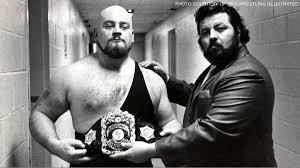 Ivan Koloff and manager Captain Louis AlbanoNowadays the thought of a champion holding the belt for over seven and a half years is inconceivable. A title reign over a year is a big deal in today’s era of professional wrestling. The business is different now with a multitude of TV and pay-per- view shows where the titleis defended compared to the time before cable television and PPV where titles were usually only defended at house shows. What was it like for fans when a champion was upended after a long reign? How did promoters book such a loss? Join me as I look back at the night Bruno Sammartino dropped the (World Wide Wrestling Federation) WWWF title to Ivan Koloff in an amazing upset. The night Madison Square Garden went silent.Join me as I look back at one of the biggest nights in Madison Square Garden history.Originally presented at Canadian Bulldog's World
Ivan Koloff and manager Captain Louis AlbanoNowadays the thought of a champion holding the belt for over seven and a half years is inconceivable. A title reign over a year is a big deal in today’s era of professional wrestling. The business is different now with a multitude of TV and pay-per- view shows where the titleis defended compared to the time before cable television and PPV where titles were usually only defended at house shows. What was it like for fans when a champion was upended after a long reign? How did promoters book such a loss? Join me as I look back at the night Bruno Sammartino dropped the (World Wide Wrestling Federation) WWWF title to Ivan Koloff in an amazing upset. The night Madison Square Garden went silent.Join me as I look back at one of the biggest nights in Madison Square Garden history.Originally presented at Canadian Bulldog's World
Published on September 09, 2018 22:08
September 6, 2018
At Long Last, Lincoln. My 13-Days in England
Copyright (C) 2018 by Michael Rickard II I Lincoln, a beautiful cathedral city.I'd arrived in Lincoln a day early to get ready for Bishop Grosseteste University’s Monster Conference, and while I wasn’t scheduled to present until Sunday, I wanted to appear for the opening ceremony and check things out. Foreshadowing Sunday, I’d find there are many ways to Bishop Grosseteste University, not all of them short.
Lincoln, a beautiful cathedral city.I'd arrived in Lincoln a day early to get ready for Bishop Grosseteste University’s Monster Conference, and while I wasn’t scheduled to present until Sunday, I wanted to appear for the opening ceremony and check things out. Foreshadowing Sunday, I’d find there are many ways to Bishop Grosseteste University, not all of them short. The bottom of a long, long hill.Lincoln is a cathedral city located in northern United Kingdom. While it initially appeared to be a small town, I later discovered it’s actually bigger. The city’s earliest settlement is believed to date back to the first century B.C. and has seen many changes ranging from Roman occupation, Viking raids, the construction of the world’s largest building (Lincoln Cathedral in 1300), the Industrial Revolution, the construction of the first tanks, and Lincoln’s continued growth in universities and engineering. I would later learn that Lincoln has one of the world’s oldest Bibles as well as one of four surviving copies of the Magna Carta.Along the way, I also learned Lincoln has the steepest hill in all of the UK, a hill I found myself traversing when I went to Lincoln. My Air BnB host gave me directions to Bishop Grosseteste University, directions I misunderstood. Before long, I was heading down a hill and kept going until I reached the bottom. I was hungry and asked a passerby for directions to the nearest restaurant.
The bottom of a long, long hill.Lincoln is a cathedral city located in northern United Kingdom. While it initially appeared to be a small town, I later discovered it’s actually bigger. The city’s earliest settlement is believed to date back to the first century B.C. and has seen many changes ranging from Roman occupation, Viking raids, the construction of the world’s largest building (Lincoln Cathedral in 1300), the Industrial Revolution, the construction of the first tanks, and Lincoln’s continued growth in universities and engineering. I would later learn that Lincoln has one of the world’s oldest Bibles as well as one of four surviving copies of the Magna Carta.Along the way, I also learned Lincoln has the steepest hill in all of the UK, a hill I found myself traversing when I went to Lincoln. My Air BnB host gave me directions to Bishop Grosseteste University, directions I misunderstood. Before long, I was heading down a hill and kept going until I reached the bottom. I was hungry and asked a passerby for directions to the nearest restaurant. You can never go wrong with an English breakfastI soon found an out of the way café called Elena’s Kitchen. The place was tiny but homey and they featured a surprisingly big breakfast menu for a small shop. I ordered a full English breakfast, knowing I probably wouldn’t eat for some time. The breakfast was delicious. I asked my waitress how far Bishop Grosseteste was and was informed it was only about a mile walk—not bad for uphill. I immediately called a cab service I’d used before (Hansom Cab) and knew they were economical, but you usually had a bit of a wait. With forty minutes to kill, I ordered a piece of chocolate cake and a tall glass of milk. I chatted with some of the people in the café then waited outside for my ride.
You can never go wrong with an English breakfastI soon found an out of the way café called Elena’s Kitchen. The place was tiny but homey and they featured a surprisingly big breakfast menu for a small shop. I ordered a full English breakfast, knowing I probably wouldn’t eat for some time. The breakfast was delicious. I asked my waitress how far Bishop Grosseteste was and was informed it was only about a mile walk—not bad for uphill. I immediately called a cab service I’d used before (Hansom Cab) and knew they were economical, but you usually had a bit of a wait. With forty minutes to kill, I ordered a piece of chocolate cake and a tall glass of milk. I chatted with some of the people in the café then waited outside for my ride. A wonderful discovery in LincolnI made it to Bishop Grosseteste University with plenty of time to spare and picked up my registration kit. I chatted up with the owner of a local bookstore who was selling some Mary Shelly books and Gothic novels. I picked up Mary’s mom’s book, A Vindication of the Rights of Woman and A Vindication of the Rights of Men. From what I knew Mary Shelly was radical for her day, and her mother Mary Wollstonecraft was no different.The conference got off to a good start and this time I made sure I had good directions to get back to my Air BnB. I wasn’t going to get lost again—or so I thought. While I’d make it back okay this time, my return trip for the day of my presentation wouldn’t go as well.
A wonderful discovery in LincolnI made it to Bishop Grosseteste University with plenty of time to spare and picked up my registration kit. I chatted up with the owner of a local bookstore who was selling some Mary Shelly books and Gothic novels. I picked up Mary’s mom’s book, A Vindication of the Rights of Woman and A Vindication of the Rights of Men. From what I knew Mary Shelly was radical for her day, and her mother Mary Wollstonecraft was no different.The conference got off to a good start and this time I made sure I had good directions to get back to my Air BnB. I wasn’t going to get lost again—or so I thought. While I’d make it back okay this time, my return trip for the day of my presentation wouldn’t go as well. Works Referenced“About Lincoln: A Historic City with A Vibrant and Contemporary Edge.” Visit Lincoln. AboutLincoln. 2018. https://www.visitlincoln.com/about-li.... Accessed 1 Sept. 2018.Wikipedia contributors. "Lincoln, England." Wikipedia, The Free Encyclopedia. Wikipedia, TheFree Encyclopedia, 25 Aug. 2018. https://en.wikipedia.org/wiki/Lincoln.... Accessed 1 Sep. 2018.
Works Referenced“About Lincoln: A Historic City with A Vibrant and Contemporary Edge.” Visit Lincoln. AboutLincoln. 2018. https://www.visitlincoln.com/about-li.... Accessed 1 Sept. 2018.Wikipedia contributors. "Lincoln, England." Wikipedia, The Free Encyclopedia. Wikipedia, TheFree Encyclopedia, 25 Aug. 2018. https://en.wikipedia.org/wiki/Lincoln.... Accessed 1 Sep. 2018.
 Lincoln, a beautiful cathedral city.I'd arrived in Lincoln a day early to get ready for Bishop Grosseteste University’s Monster Conference, and while I wasn’t scheduled to present until Sunday, I wanted to appear for the opening ceremony and check things out. Foreshadowing Sunday, I’d find there are many ways to Bishop Grosseteste University, not all of them short.
Lincoln, a beautiful cathedral city.I'd arrived in Lincoln a day early to get ready for Bishop Grosseteste University’s Monster Conference, and while I wasn’t scheduled to present until Sunday, I wanted to appear for the opening ceremony and check things out. Foreshadowing Sunday, I’d find there are many ways to Bishop Grosseteste University, not all of them short. The bottom of a long, long hill.Lincoln is a cathedral city located in northern United Kingdom. While it initially appeared to be a small town, I later discovered it’s actually bigger. The city’s earliest settlement is believed to date back to the first century B.C. and has seen many changes ranging from Roman occupation, Viking raids, the construction of the world’s largest building (Lincoln Cathedral in 1300), the Industrial Revolution, the construction of the first tanks, and Lincoln’s continued growth in universities and engineering. I would later learn that Lincoln has one of the world’s oldest Bibles as well as one of four surviving copies of the Magna Carta.Along the way, I also learned Lincoln has the steepest hill in all of the UK, a hill I found myself traversing when I went to Lincoln. My Air BnB host gave me directions to Bishop Grosseteste University, directions I misunderstood. Before long, I was heading down a hill and kept going until I reached the bottom. I was hungry and asked a passerby for directions to the nearest restaurant.
The bottom of a long, long hill.Lincoln is a cathedral city located in northern United Kingdom. While it initially appeared to be a small town, I later discovered it’s actually bigger. The city’s earliest settlement is believed to date back to the first century B.C. and has seen many changes ranging from Roman occupation, Viking raids, the construction of the world’s largest building (Lincoln Cathedral in 1300), the Industrial Revolution, the construction of the first tanks, and Lincoln’s continued growth in universities and engineering. I would later learn that Lincoln has one of the world’s oldest Bibles as well as one of four surviving copies of the Magna Carta.Along the way, I also learned Lincoln has the steepest hill in all of the UK, a hill I found myself traversing when I went to Lincoln. My Air BnB host gave me directions to Bishop Grosseteste University, directions I misunderstood. Before long, I was heading down a hill and kept going until I reached the bottom. I was hungry and asked a passerby for directions to the nearest restaurant. You can never go wrong with an English breakfastI soon found an out of the way café called Elena’s Kitchen. The place was tiny but homey and they featured a surprisingly big breakfast menu for a small shop. I ordered a full English breakfast, knowing I probably wouldn’t eat for some time. The breakfast was delicious. I asked my waitress how far Bishop Grosseteste was and was informed it was only about a mile walk—not bad for uphill. I immediately called a cab service I’d used before (Hansom Cab) and knew they were economical, but you usually had a bit of a wait. With forty minutes to kill, I ordered a piece of chocolate cake and a tall glass of milk. I chatted with some of the people in the café then waited outside for my ride.
You can never go wrong with an English breakfastI soon found an out of the way café called Elena’s Kitchen. The place was tiny but homey and they featured a surprisingly big breakfast menu for a small shop. I ordered a full English breakfast, knowing I probably wouldn’t eat for some time. The breakfast was delicious. I asked my waitress how far Bishop Grosseteste was and was informed it was only about a mile walk—not bad for uphill. I immediately called a cab service I’d used before (Hansom Cab) and knew they were economical, but you usually had a bit of a wait. With forty minutes to kill, I ordered a piece of chocolate cake and a tall glass of milk. I chatted with some of the people in the café then waited outside for my ride. A wonderful discovery in LincolnI made it to Bishop Grosseteste University with plenty of time to spare and picked up my registration kit. I chatted up with the owner of a local bookstore who was selling some Mary Shelly books and Gothic novels. I picked up Mary’s mom’s book, A Vindication of the Rights of Woman and A Vindication of the Rights of Men. From what I knew Mary Shelly was radical for her day, and her mother Mary Wollstonecraft was no different.The conference got off to a good start and this time I made sure I had good directions to get back to my Air BnB. I wasn’t going to get lost again—or so I thought. While I’d make it back okay this time, my return trip for the day of my presentation wouldn’t go as well.
A wonderful discovery in LincolnI made it to Bishop Grosseteste University with plenty of time to spare and picked up my registration kit. I chatted up with the owner of a local bookstore who was selling some Mary Shelly books and Gothic novels. I picked up Mary’s mom’s book, A Vindication of the Rights of Woman and A Vindication of the Rights of Men. From what I knew Mary Shelly was radical for her day, and her mother Mary Wollstonecraft was no different.The conference got off to a good start and this time I made sure I had good directions to get back to my Air BnB. I wasn’t going to get lost again—or so I thought. While I’d make it back okay this time, my return trip for the day of my presentation wouldn’t go as well. Works Referenced“About Lincoln: A Historic City with A Vibrant and Contemporary Edge.” Visit Lincoln. AboutLincoln. 2018. https://www.visitlincoln.com/about-li.... Accessed 1 Sept. 2018.Wikipedia contributors. "Lincoln, England." Wikipedia, The Free Encyclopedia. Wikipedia, TheFree Encyclopedia, 25 Aug. 2018. https://en.wikipedia.org/wiki/Lincoln.... Accessed 1 Sep. 2018.
Works Referenced“About Lincoln: A Historic City with A Vibrant and Contemporary Edge.” Visit Lincoln. AboutLincoln. 2018. https://www.visitlincoln.com/about-li.... Accessed 1 Sept. 2018.Wikipedia contributors. "Lincoln, England." Wikipedia, The Free Encyclopedia. Wikipedia, TheFree Encyclopedia, 25 Aug. 2018. https://en.wikipedia.org/wiki/Lincoln.... Accessed 1 Sep. 2018.
Published on September 06, 2018 22:27
September 3, 2018
Book Review: Brutus Beefcake's "Struttin' and Cuttin'" Proves Fun Read
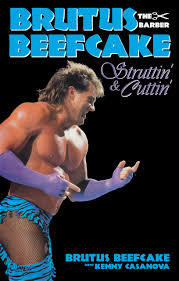 Fans may be wondering what Brutus Beefcake has to say about his time in the squared circle and let me tell you brother, he has a lot to day, including some funny road stories and interesting insight into his early days training with Hulk Hogan and subsequent success. Check out my review of Struttin' and Cuttin'here.Originally presented at Canadian Bulldog's World
Fans may be wondering what Brutus Beefcake has to say about his time in the squared circle and let me tell you brother, he has a lot to day, including some funny road stories and interesting insight into his early days training with Hulk Hogan and subsequent success. Check out my review of Struttin' and Cuttin'here.Originally presented at Canadian Bulldog's World
Published on September 03, 2018 02:51
August 30, 2018
Chick Lit on the Border: Unheard Voices in "Loving Pedro Infante"
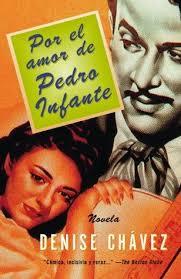 Copyright (c) 2018 by Michael Rickard IIEditor's Note:The border is a hot topic right now thus my class in borderland literature provided some insight into authors' thoughts on living between two worlds. Here is an essay I wrote on Emma Pérez' Loving Pedro Infante.As Emma Pérez explores how Chicanas’ voices have been silenced in the Chicano movement in her book The Decolonial Imagery, Denise Chavez gives voice to Chicanas in her novel Loving Pedro Infante, a tale of friendship, love, and life as a Chicana. Chavez uses the characters’ shared love for the films of Pedro Infante to explore their relationships and individual approaches to life. Pedro Infante’s films serve as an allegory for Pérez’ exploration of history and metahistory with Pedro’s films having distinct phases just as Pérez argues Chicano history traditionally “manifests four periods and four dominant modes of thinking” (8). However, just as Pérez argues Chicano history cannot easily be fit into four periods, Chavez shows how Pedro Infante’s films and personal life are not as easily categorized as thought. Chavez explores borderland themes such as culture, ethnicity, gender, and sexual identity in Loving Pedro Infante in a subtle, but effective way.In her book, The Decolonial Imaginary: Writing Chicanas into History (Theories of Representation and Difference), Pérez comments on how Chicano studies failed to pay attention to Chicanas, instead focusing on Chicanos as a group or only men. As Pérez notes:“Although the historians failed to raise gender, much less sexuality, as a category of analysis, the trend in early academic studies was to deliberate about women only when they were being depicted as exploited workers alongside men” (10). Part of Loving Pedro Infante’s appeal is its exploration of life of Chicanas. Although the book focuses mainly on the characters’ identities as women, it does discuss life as Chicanas, giving voice to the voiceless. Chavez abandons the notion of leaving life as a Chicana as interstitial. Chicana life is a reach experience that cannot be limited to reading between the lines, which Loving Pedro Infante demonstrates through its story of two friends searching for love and happiness.Chavez explores the friendship between Teresa and Irma, a friendship strengthened by their passion for the films of Pedro Infante. Their mutual love of Pedro is also a reflection of their idealized man—someone who looks and behaves like Pedro Infante. However, when Teresa thinks she finds such a man in Lucio, she eventually learns Lucio is selfish and misogynistic. She has no future with Lucio other than as his mistress, secondary to Lucio’s life with his wife and daughter. Likewise, Irma sets the relationship bar high, but eventually finds love with her Anglo employer Mr. Wesley. Irma and Wesley’s unconventional relationship mirrors the theme of borderland literature where social conventions are defied in order to find a certain measure of happiness and satisfaction. Although there is no strict connection between the career of Pedro and the four tropes of Chicano history mentioned by Pérez, there are comparisons. Pedro’s life was divided into distinct periods represented by his marriages and affairs, as well as his films. These divisions are similar to how Pérez notes the four tropes of Chicano history. Each share parallels as while there is truth to be found in Pedro’s life, overgeneralizations cloud what actually happened just as strict definitions in history obscure the overall picture of Chicano history, limiting our understanding of it. Teresa’s idealization of Pedro and the reality of Pedro’s life help her to discover the strength to leave Lucio. Teresa realizes Pedro was a man, but she also sees good in Pedro as more than a man, i.e., an ideal. When Teresa thinks, “For as long as there is breath in my body, I’ll always love him, just the way he was” (Chavez 317), she reaffirms her belief that there are ideals to strive for in a man, and although she has not found such a man yet, she knows what she is willing to accept.Chavez incorporates many of the issues found in borderland literature As Gloria Anzaldúa discusses in Borderlands / La Frontera: The New Mestiza, there are many aspects to the borderland than geography. There are issues of ethnicity, gender, sexuality, and economy. Loving Pedro Infante includes these whether it is borderland culture such as Pedro Infante’s films, the gender issues Teresa and Irma experience as women, sexual identity (both heterosexual and homosexual), and economy (Teresa’s marginal socioeconomic status compared to Lucio’s). These various issues are dealt with in the background for the most part, but they are nonetheless palpable.Teresa also looks to a heroine for comparing her life, tying in with Pérez’ concept that Chicanas were overlooked in Chicano history unless they served some heroic purpose. Teresa compares her life to “my tocaya, La Santa Tere” (68). Teresa’s namesake St. Teresa is different than her, but as with all heroes and heroines, Teresa has something she can strive for.Loving Pedro Infante uses a mix of English and Spanish words, much like many of the other borderland stories studied in class. This creates a sense of how the characters live in a hybrid of two worlds. For example, Teresa and Graciela argue about a man Graciela is dancing with, leading to Graciela asking Teresa if she is calling her (Graciela) a cabrana (32). Later in the conversation, Graciela asks, “Since when are you such a pendeja, Tere?” (32). Both words in Mexican-Spanish can be pejoratives and it adds to the novel’s borderland setting.Loving Pedro Infante uses Teresa’s search for enduring and committed love as an allegory for how women can be exploited by men. Teresa is blind to the harmful effects of her relationship with married man Lucio, naively believing Lucio will leave his wife. This relationship hurts Teresa’s self-esteem and her relationship with her best friend Irma. Chavez explores Teresa’s struggle to free herself from the toxic relationship and to restore her friendship with Irma. Chavez shows how some relationships can be nurturing and some can be harmful, adding balance to the story with the positive bond between Irma and Wesley, and contrasting it with the toxic one between Teresa and Lucio.Teresa and Irma’s stories allow for an exploration of friendship and the search for enduring love. It also allows for an exploration of Chicana life. It is wrong to say the book is an exploration of Chicana life primarily. Instead, Loving Pedro Infante explores the lives of two women, and there is a secondary exploration of their lives as Chicanas in the areas of culture, ethnicity, gender, sexual identity, and economic status.Works CitedChavez, Denise. Loving Pedro Infante. Washington Square Press, 2002.Pérez, Emma. The Decolonial Imaginary: Writing Chicanas into History (Theories of Representation and Difference). Indiana University Press, 1999.
Copyright (c) 2018 by Michael Rickard IIEditor's Note:The border is a hot topic right now thus my class in borderland literature provided some insight into authors' thoughts on living between two worlds. Here is an essay I wrote on Emma Pérez' Loving Pedro Infante.As Emma Pérez explores how Chicanas’ voices have been silenced in the Chicano movement in her book The Decolonial Imagery, Denise Chavez gives voice to Chicanas in her novel Loving Pedro Infante, a tale of friendship, love, and life as a Chicana. Chavez uses the characters’ shared love for the films of Pedro Infante to explore their relationships and individual approaches to life. Pedro Infante’s films serve as an allegory for Pérez’ exploration of history and metahistory with Pedro’s films having distinct phases just as Pérez argues Chicano history traditionally “manifests four periods and four dominant modes of thinking” (8). However, just as Pérez argues Chicano history cannot easily be fit into four periods, Chavez shows how Pedro Infante’s films and personal life are not as easily categorized as thought. Chavez explores borderland themes such as culture, ethnicity, gender, and sexual identity in Loving Pedro Infante in a subtle, but effective way.In her book, The Decolonial Imaginary: Writing Chicanas into History (Theories of Representation and Difference), Pérez comments on how Chicano studies failed to pay attention to Chicanas, instead focusing on Chicanos as a group or only men. As Pérez notes:“Although the historians failed to raise gender, much less sexuality, as a category of analysis, the trend in early academic studies was to deliberate about women only when they were being depicted as exploited workers alongside men” (10). Part of Loving Pedro Infante’s appeal is its exploration of life of Chicanas. Although the book focuses mainly on the characters’ identities as women, it does discuss life as Chicanas, giving voice to the voiceless. Chavez abandons the notion of leaving life as a Chicana as interstitial. Chicana life is a reach experience that cannot be limited to reading between the lines, which Loving Pedro Infante demonstrates through its story of two friends searching for love and happiness.Chavez explores the friendship between Teresa and Irma, a friendship strengthened by their passion for the films of Pedro Infante. Their mutual love of Pedro is also a reflection of their idealized man—someone who looks and behaves like Pedro Infante. However, when Teresa thinks she finds such a man in Lucio, she eventually learns Lucio is selfish and misogynistic. She has no future with Lucio other than as his mistress, secondary to Lucio’s life with his wife and daughter. Likewise, Irma sets the relationship bar high, but eventually finds love with her Anglo employer Mr. Wesley. Irma and Wesley’s unconventional relationship mirrors the theme of borderland literature where social conventions are defied in order to find a certain measure of happiness and satisfaction. Although there is no strict connection between the career of Pedro and the four tropes of Chicano history mentioned by Pérez, there are comparisons. Pedro’s life was divided into distinct periods represented by his marriages and affairs, as well as his films. These divisions are similar to how Pérez notes the four tropes of Chicano history. Each share parallels as while there is truth to be found in Pedro’s life, overgeneralizations cloud what actually happened just as strict definitions in history obscure the overall picture of Chicano history, limiting our understanding of it. Teresa’s idealization of Pedro and the reality of Pedro’s life help her to discover the strength to leave Lucio. Teresa realizes Pedro was a man, but she also sees good in Pedro as more than a man, i.e., an ideal. When Teresa thinks, “For as long as there is breath in my body, I’ll always love him, just the way he was” (Chavez 317), she reaffirms her belief that there are ideals to strive for in a man, and although she has not found such a man yet, she knows what she is willing to accept.Chavez incorporates many of the issues found in borderland literature As Gloria Anzaldúa discusses in Borderlands / La Frontera: The New Mestiza, there are many aspects to the borderland than geography. There are issues of ethnicity, gender, sexuality, and economy. Loving Pedro Infante includes these whether it is borderland culture such as Pedro Infante’s films, the gender issues Teresa and Irma experience as women, sexual identity (both heterosexual and homosexual), and economy (Teresa’s marginal socioeconomic status compared to Lucio’s). These various issues are dealt with in the background for the most part, but they are nonetheless palpable.Teresa also looks to a heroine for comparing her life, tying in with Pérez’ concept that Chicanas were overlooked in Chicano history unless they served some heroic purpose. Teresa compares her life to “my tocaya, La Santa Tere” (68). Teresa’s namesake St. Teresa is different than her, but as with all heroes and heroines, Teresa has something she can strive for.Loving Pedro Infante uses a mix of English and Spanish words, much like many of the other borderland stories studied in class. This creates a sense of how the characters live in a hybrid of two worlds. For example, Teresa and Graciela argue about a man Graciela is dancing with, leading to Graciela asking Teresa if she is calling her (Graciela) a cabrana (32). Later in the conversation, Graciela asks, “Since when are you such a pendeja, Tere?” (32). Both words in Mexican-Spanish can be pejoratives and it adds to the novel’s borderland setting.Loving Pedro Infante uses Teresa’s search for enduring and committed love as an allegory for how women can be exploited by men. Teresa is blind to the harmful effects of her relationship with married man Lucio, naively believing Lucio will leave his wife. This relationship hurts Teresa’s self-esteem and her relationship with her best friend Irma. Chavez explores Teresa’s struggle to free herself from the toxic relationship and to restore her friendship with Irma. Chavez shows how some relationships can be nurturing and some can be harmful, adding balance to the story with the positive bond between Irma and Wesley, and contrasting it with the toxic one between Teresa and Lucio.Teresa and Irma’s stories allow for an exploration of friendship and the search for enduring love. It also allows for an exploration of Chicana life. It is wrong to say the book is an exploration of Chicana life primarily. Instead, Loving Pedro Infante explores the lives of two women, and there is a secondary exploration of their lives as Chicanas in the areas of culture, ethnicity, gender, sexual identity, and economic status.Works CitedChavez, Denise. Loving Pedro Infante. Washington Square Press, 2002.Pérez, Emma. The Decolonial Imaginary: Writing Chicanas into History (Theories of Representation and Difference). Indiana University Press, 1999.
Published on August 30, 2018 21:10
August 28, 2018
The Kindness of Strangers: Heading to Lincoln. My 13-Days in England
Copyright (C) 2018 by Michael Rickard II“I have always depended on the kindness of strangers.” Blanche DuBois, A Streetcar Named Desire. 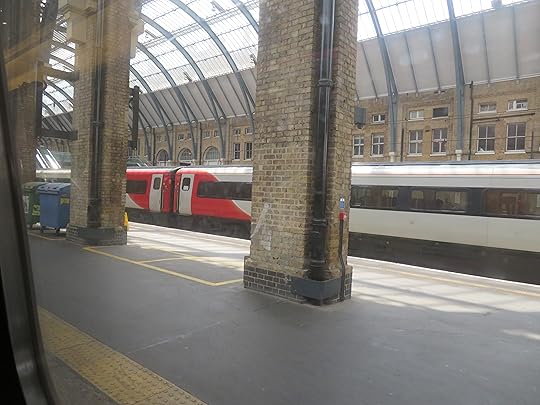 After four glorious days in London, it was time to head to Lincoln for the Monster Conference. After consulting with the host at my bed and breakfast, I found the best route to get there via train. However, like any journey, things going smoothly tends to be the exception rather than the rule. Along the way I would get by thanks to some help from some kind-hearted people.
After four glorious days in London, it was time to head to Lincoln for the Monster Conference. After consulting with the host at my bed and breakfast, I found the best route to get there via train. However, like any journey, things going smoothly tends to be the exception rather than the rule. Along the way I would get by thanks to some help from some kind-hearted people.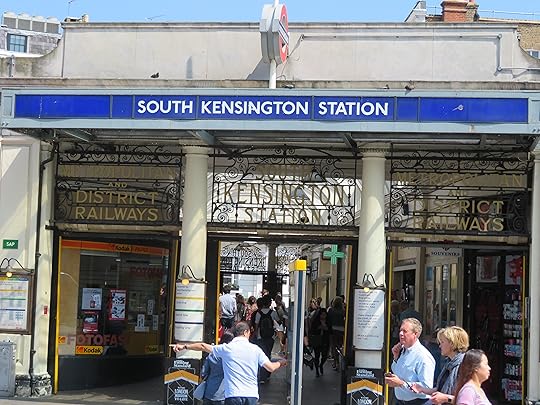 As I mentioned earlier, London has a fantastic mass transit system. I took a bus to South Kensington Station where I would take the tube to a train station. As always, I left hours in advance because when you’re traveling in a foreign country, you want to stack the deck in your favor should Lady Luck decide to walk out on you. Unlike Frank Sinatra, I wasn’t counting on luck being a lady tonight.
As I mentioned earlier, London has a fantastic mass transit system. I took a bus to South Kensington Station where I would take the tube to a train station. As always, I left hours in advance because when you’re traveling in a foreign country, you want to stack the deck in your favor should Lady Luck decide to walk out on you. Unlike Frank Sinatra, I wasn’t counting on luck being a lady tonight. Travel Rule One: Always load up on food! The bus arrived near South Kensington station so I grabbed a nice breakfast consisting of poached eggs with salmon. Add in some cranberry juice and an espresso and you had a great start to the day. I’d already fortified myself with some cereal before I left my Air BnB, but the more food in the belly, the better when you don’t know when lunch will be.
Travel Rule One: Always load up on food! The bus arrived near South Kensington station so I grabbed a nice breakfast consisting of poached eggs with salmon. Add in some cranberry juice and an espresso and you had a great start to the day. I’d already fortified myself with some cereal before I left my Air BnB, but the more food in the belly, the better when you don’t know when lunch will be. Poached eggs with salmon. The Tube ride to the train station proved uneventful, but I was a bit overwhelmed by the various trains as well as the schedule. I’ve never traveled by train so this was a first. I had two hours until my train was scheduled to arrive so I sat down and talked to a couple whose son had just returned from China. They explained how to read the train schedule and I was ready. I found the departing gate for my train and waited. While I did, I met a couple from Lincoln who were in London to visit their daughter. They gave me some recommendations on good restaurants in Lincoln.
Poached eggs with salmon. The Tube ride to the train station proved uneventful, but I was a bit overwhelmed by the various trains as well as the schedule. I’ve never traveled by train so this was a first. I had two hours until my train was scheduled to arrive so I sat down and talked to a couple whose son had just returned from China. They explained how to read the train schedule and I was ready. I found the departing gate for my train and waited. While I did, I met a couple from Lincoln who were in London to visit their daughter. They gave me some recommendations on good restaurants in Lincoln. 

 Busy train station The train ride was a pleasant surprise as it was one of the rare places I enjoyed air conditioning in England. The ride was comfortable and I arrived at a station where I was going to catch the train to Lincoln. There, I met a professor who taught in London, but lived in Lincoln. I told her I was heading to Lincoln for The Monster Conference and she shared some tips on places to check out in Lincoln. She jokingly told me that the Grosseteste in Bishop Grosseteste University stood for in Latin, a joke I'll leave for the Latin scholars to figure out.
Busy train station The train ride was a pleasant surprise as it was one of the rare places I enjoyed air conditioning in England. The ride was comfortable and I arrived at a station where I was going to catch the train to Lincoln. There, I met a professor who taught in London, but lived in Lincoln. I told her I was heading to Lincoln for The Monster Conference and she shared some tips on places to check out in Lincoln. She jokingly told me that the Grosseteste in Bishop Grosseteste University stood for in Latin, a joke I'll leave for the Latin scholars to figure out. 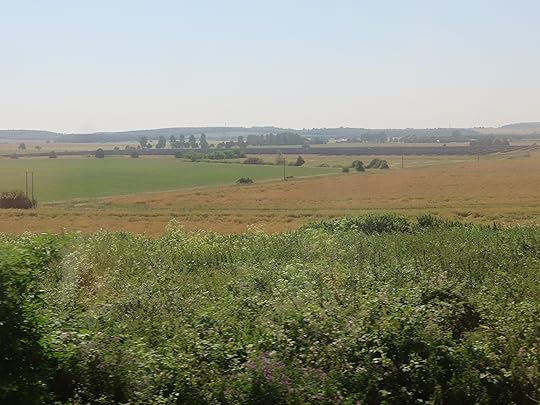 Lots of country scenery during to train ride to LincolnThe train to Lincoln looked like something out of the Victorian era. Coincidentally, the professor told me England’s rails are largely from the Victorian age which means some areas can’t be traveled on beyond 20-30 miles per hour. Sadly, this train car (there was only one car for the trip to Lincoln) wasn’t air-conditioned, but there was a decent breeze. It looked like there’d only be a handful of people, but suddenly the train filled up and it was packed to the brim. This ride was a bit less comfortable as people were crowded and it looked like a busy subway car rather than a train. When we arrived, my professor friend arranged for a cab (recall I had no cell phone to call a cab) as there was no way I was going to walk to my Air BnB from the train station.
Lots of country scenery during to train ride to LincolnThe train to Lincoln looked like something out of the Victorian era. Coincidentally, the professor told me England’s rails are largely from the Victorian age which means some areas can’t be traveled on beyond 20-30 miles per hour. Sadly, this train car (there was only one car for the trip to Lincoln) wasn’t air-conditioned, but there was a decent breeze. It looked like there’d only be a handful of people, but suddenly the train filled up and it was packed to the brim. This ride was a bit less comfortable as people were crowded and it looked like a busy subway car rather than a train. When we arrived, my professor friend arranged for a cab (recall I had no cell phone to call a cab) as there was no way I was going to walk to my Air BnB from the train station.  Another great Air BnB location. Yes, I had to be cautious as I was in a foreign country, but I trusted my gut and was blessed by the goodwill of complete strangers. They made my trip a bit nicer and while I didn’t run into any problems, they helped me prepare better for when I arrived at Lincoln as well as provided some company for the journey. It reminded me not to be so judgmental the next time I see a goofy tourist trying to find their way around because this time around, that goofy tourist was me.
Another great Air BnB location. Yes, I had to be cautious as I was in a foreign country, but I trusted my gut and was blessed by the goodwill of complete strangers. They made my trip a bit nicer and while I didn’t run into any problems, they helped me prepare better for when I arrived at Lincoln as well as provided some company for the journey. It reminded me not to be so judgmental the next time I see a goofy tourist trying to find their way around because this time around, that goofy tourist was me.
 After four glorious days in London, it was time to head to Lincoln for the Monster Conference. After consulting with the host at my bed and breakfast, I found the best route to get there via train. However, like any journey, things going smoothly tends to be the exception rather than the rule. Along the way I would get by thanks to some help from some kind-hearted people.
After four glorious days in London, it was time to head to Lincoln for the Monster Conference. After consulting with the host at my bed and breakfast, I found the best route to get there via train. However, like any journey, things going smoothly tends to be the exception rather than the rule. Along the way I would get by thanks to some help from some kind-hearted people. As I mentioned earlier, London has a fantastic mass transit system. I took a bus to South Kensington Station where I would take the tube to a train station. As always, I left hours in advance because when you’re traveling in a foreign country, you want to stack the deck in your favor should Lady Luck decide to walk out on you. Unlike Frank Sinatra, I wasn’t counting on luck being a lady tonight.
As I mentioned earlier, London has a fantastic mass transit system. I took a bus to South Kensington Station where I would take the tube to a train station. As always, I left hours in advance because when you’re traveling in a foreign country, you want to stack the deck in your favor should Lady Luck decide to walk out on you. Unlike Frank Sinatra, I wasn’t counting on luck being a lady tonight. Travel Rule One: Always load up on food! The bus arrived near South Kensington station so I grabbed a nice breakfast consisting of poached eggs with salmon. Add in some cranberry juice and an espresso and you had a great start to the day. I’d already fortified myself with some cereal before I left my Air BnB, but the more food in the belly, the better when you don’t know when lunch will be.
Travel Rule One: Always load up on food! The bus arrived near South Kensington station so I grabbed a nice breakfast consisting of poached eggs with salmon. Add in some cranberry juice and an espresso and you had a great start to the day. I’d already fortified myself with some cereal before I left my Air BnB, but the more food in the belly, the better when you don’t know when lunch will be. Poached eggs with salmon. The Tube ride to the train station proved uneventful, but I was a bit overwhelmed by the various trains as well as the schedule. I’ve never traveled by train so this was a first. I had two hours until my train was scheduled to arrive so I sat down and talked to a couple whose son had just returned from China. They explained how to read the train schedule and I was ready. I found the departing gate for my train and waited. While I did, I met a couple from Lincoln who were in London to visit their daughter. They gave me some recommendations on good restaurants in Lincoln.
Poached eggs with salmon. The Tube ride to the train station proved uneventful, but I was a bit overwhelmed by the various trains as well as the schedule. I’ve never traveled by train so this was a first. I had two hours until my train was scheduled to arrive so I sat down and talked to a couple whose son had just returned from China. They explained how to read the train schedule and I was ready. I found the departing gate for my train and waited. While I did, I met a couple from Lincoln who were in London to visit their daughter. They gave me some recommendations on good restaurants in Lincoln. 

 Busy train station The train ride was a pleasant surprise as it was one of the rare places I enjoyed air conditioning in England. The ride was comfortable and I arrived at a station where I was going to catch the train to Lincoln. There, I met a professor who taught in London, but lived in Lincoln. I told her I was heading to Lincoln for The Monster Conference and she shared some tips on places to check out in Lincoln. She jokingly told me that the Grosseteste in Bishop Grosseteste University stood for in Latin, a joke I'll leave for the Latin scholars to figure out.
Busy train station The train ride was a pleasant surprise as it was one of the rare places I enjoyed air conditioning in England. The ride was comfortable and I arrived at a station where I was going to catch the train to Lincoln. There, I met a professor who taught in London, but lived in Lincoln. I told her I was heading to Lincoln for The Monster Conference and she shared some tips on places to check out in Lincoln. She jokingly told me that the Grosseteste in Bishop Grosseteste University stood for in Latin, a joke I'll leave for the Latin scholars to figure out.  Lots of country scenery during to train ride to LincolnThe train to Lincoln looked like something out of the Victorian era. Coincidentally, the professor told me England’s rails are largely from the Victorian age which means some areas can’t be traveled on beyond 20-30 miles per hour. Sadly, this train car (there was only one car for the trip to Lincoln) wasn’t air-conditioned, but there was a decent breeze. It looked like there’d only be a handful of people, but suddenly the train filled up and it was packed to the brim. This ride was a bit less comfortable as people were crowded and it looked like a busy subway car rather than a train. When we arrived, my professor friend arranged for a cab (recall I had no cell phone to call a cab) as there was no way I was going to walk to my Air BnB from the train station.
Lots of country scenery during to train ride to LincolnThe train to Lincoln looked like something out of the Victorian era. Coincidentally, the professor told me England’s rails are largely from the Victorian age which means some areas can’t be traveled on beyond 20-30 miles per hour. Sadly, this train car (there was only one car for the trip to Lincoln) wasn’t air-conditioned, but there was a decent breeze. It looked like there’d only be a handful of people, but suddenly the train filled up and it was packed to the brim. This ride was a bit less comfortable as people were crowded and it looked like a busy subway car rather than a train. When we arrived, my professor friend arranged for a cab (recall I had no cell phone to call a cab) as there was no way I was going to walk to my Air BnB from the train station.  Another great Air BnB location. Yes, I had to be cautious as I was in a foreign country, but I trusted my gut and was blessed by the goodwill of complete strangers. They made my trip a bit nicer and while I didn’t run into any problems, they helped me prepare better for when I arrived at Lincoln as well as provided some company for the journey. It reminded me not to be so judgmental the next time I see a goofy tourist trying to find their way around because this time around, that goofy tourist was me.
Another great Air BnB location. Yes, I had to be cautious as I was in a foreign country, but I trusted my gut and was blessed by the goodwill of complete strangers. They made my trip a bit nicer and while I didn’t run into any problems, they helped me prepare better for when I arrived at Lincoln as well as provided some company for the journey. It reminded me not to be so judgmental the next time I see a goofy tourist trying to find their way around because this time around, that goofy tourist was me.
Published on August 28, 2018 23:36



